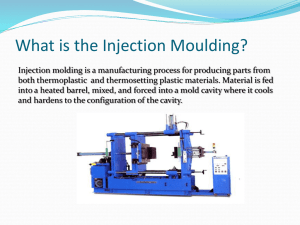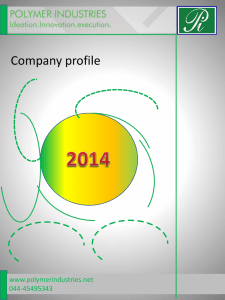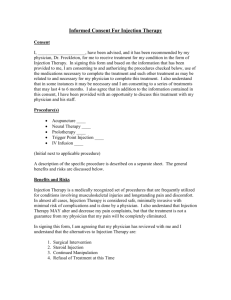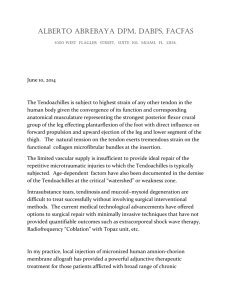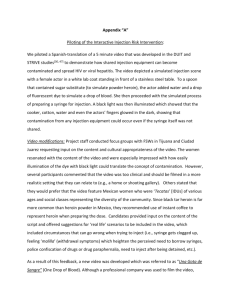Plastic Injection Molding Jesse Columbus Larry Lake Steve Lish IE
advertisement
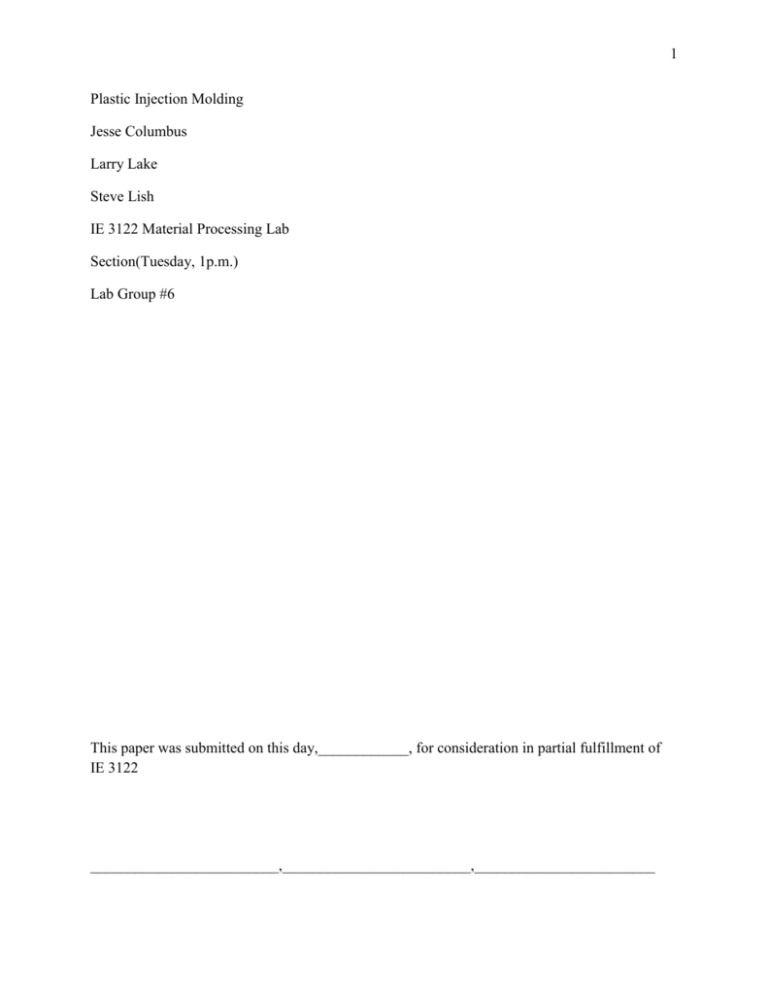
1 Plastic Injection Molding Jesse Columbus Larry Lake Steve Lish IE 3122 Material Processing Lab Section(Tuesday, 1p.m.) Lab Group #6 This paper was submitted on this day,____________, for consideration in partial fulfillment of IE 3122 _________________________,_________________________,________________________ 2 Abstract: The following report will convey information five different factors of plastic injections molding and how they affect the final part weight. The five independent variables include barrel temperature, nozzle temperature, dwell time, injection pressure, and flow rate. This independent variable will or may have an effect on the final part weight which is the dependent variable. By using a half factorial in this experiment and 3 replications for each factor studied can help conclude which factors have the most affect. The resulting data from this experiment was used in conjunction with Design Experiment to look at what factors and interactions cause the biggest. 3 Table of Contents Abstracts…………………………………………………………………………..…………….2 Table of Contents……………………………………………………………………………….3 Introduction……………………………………………………………………...…......……….4 Theory………………………………………………………………………………..….………4 Experimental Procedure…………………………………………………………..….……….5-6 Discussion…………………………………………………………………………………….7-8 Figure 1 (Plastic parts 1)………………………………………………….………..….………..9 Figure 2 (Plastic parts 2)………………………………………..………………………………9 Figure 3 (Plastic parts 3)………………………………………….……………………...……..9 Figure 4 (Plastic Mold Injector)……………………………………………………………….15 Table A (ANOVA)………………………………………………………………..…………..10 Graph A (Barrel temp)………………………………………………….…………...………..11 Graph B (Nozzle temp)……………………………………………..…………………………11 Graph C (Dwell time)……………………………………………….……………..………….12 Graph D (Injection pressure)………………………………………….……..………………..12 Graph E (Flow rate)………………………………………………………………..………….13 Conclusion…………………………………………………………………………………..….13 Appendices ……………………………………………………………………...……………..14 Work Cited……………………………………………………………………………………..15 4 Introduction: This lab takes a look at a half factorial experiment on plastic injection molding and how independent variables affect the dependent variables. These independent variables include Barrel Temperature, Nozzle Temperature, Dwell Time, Injection Pressure, and Flow Rate. This independent variable will be tested to see what affects they have on the final part weight (dependent variable). The range of the half factorial and 3 replication will help give a broad range of data to further understand what affects have the most impact on the final outcome. Theory: The first plastic injection molding machine was introduced in 1872 by John Wesley Hyatt and his brother Isaiah. When World War II hit in the 1940's the industry boomed and mass production plastic injection came about. Today's industry supplies a wide variety of injection plastics ranging from bottle caps to automotive dash boards and hair combs. Plastic injection can be very cost efficient to run with high production rates, high tolerance repeatability, low scrap and little finishing needed. Most injected polymers are either thermoplastics, thermosets or some elastomers. They range in a wide variety of alloys and blends from epoxy, phenolic, nylon, polyethylene, and polystyrene. The plastic injection machine consists of a heating and injecting unit to make the plastic injection. A heated barrel with a screw type feeder or ram feeds the material into the machine to be heated before injection. By means of pressure and the ram the material is fed into the heater to melt the plastic pellets. With more pressure and force of the ram the plastic flows into the nozzle as a liquid and into the mold where it fills the mold and cools until it is hardened. The mold is place near the nozzle of the plastic injection machine and clamped into place with a large force to keep the mold firmly in place during injection. This helps to reduce flash from the mold. After cooling the part can be ejected from the mold and the sprue can be moved as well. Many factors play into the final outcome of the injected plastic part. Temperature of the barrel and nozzle play a vital role in how viscous the plastic is when it is being injected. Pressure and flow rate aid in the injection rate and flow, too high and jetting can occur from turbulence in the flow. Flow marks can also occur is the speed is to slow for injecting. Mold design is critical to make sure that the mold fills with material and that it can be ejected from the mold. Draft angles and fillets or chamfers can help reduce voids in molds and help with ejection from the mold. 5 Experimental Procedure: Variables: By varying the independent variables stated down below will conclude the interactions between them and show if there is significant cause of that variable. Also interactions of combinations of variables will be taken into account as well. Independent Variables: Barrel Temperature, Nozzle temperature, Dwell Time, Injection Pressure, Flow Rate Dependent Variable: Part Weight Equipment Used: 1. 2. 3. 4. 5. 6. 7. 8. Safety Goggles Plastic Injection Machine Air Compressor Injections Die Molds Polyethylene Gloves Cutting Snips Weight Scale Procedure: Preliminary: 1) Turn on the plastic injection machine and let it warm up to proper operating temperature. 2) Put clean Die Mold into alignment bolts. 3) make sure the table clamp holds the mold securely. Clamp should click into place insuring proper mold clamping. (between 7 and 10 Tons) if necessary use allen wrench to adjust clamp pressure. 4) Check to following: a) Barrel Temperature b) Nozzle Temperature c) Tooling Temperature d) Clamp Pressure e) Injection Pressure f) Flow Rate 5) Injection pressure control is controlled by a T screw at air line. 6) Flow rate is controlled in the back by turning the adjustment knob. 6 7) Double check all settings before continuing. Injection Procedure: 1. 2. 3. 4. 5. 6. 7. 8. 9. Place Die Mold into alignment bolts. Clear nozzle drool with aluminum scraper. Lower table guard. Push Clamp Valve to raise bottom platen (check to hear click of the clamp) Use aluminum scrapper to cylinder hopper. Double check settings. Push injection control valve to inject plastic. Wait specified time by experiment. Pull the injection control valve to retract ram. (check hopper to make sure ram is fully retracted) 10. Pull clamp valve out to lower bottom platen. 11. Raise table guard. 12. Remove Die Mold. 13. Open mold, grasp plastic part and remove part with twist method. 14. Remove sprue with push pull method from Die Mold. 15. Check to make sure Die Mold is clean or excess plastic and debris. 16. Snip part of excess plastic consistently. 17. Weigh part. Shut Down Instruction 1. 2. 3. 4. 5. 6. Check the Clamp Valve is the out position. Lower table guard. Turn off main power switch on side of temperature control. Remove both 110V power plugs. Turn off air supply. Bleed air lines out. 7 Discussion: Questions: 1. From the ANOVA table that was produced from the collected data of the experiment it was observed that the flow rate and the injection pressure were the most impacting factors on the outcome. This conclusion can be made by comparing the F value of those two factors to the corresponding F critical values. For the injection pressure, it had an F value of 121.93 and an F critical of less than 0.0001, which makes it very significant. The F value for the flow rate was 129.74 with an F critical value of less than 0.0001, which also makes this parameter the most significant. The other parameters for this experiment also had an impact on the final result but none of them were as significant as the flow rate and the injection pressure. The next most significant factor was the dwell time, having an F value of 8.53 and an F critical value of 0.0056. the least critical factor in this process turned out to be the nozzle temperature. It had an F value of 2.10 and an F critical value of 0.1544. Another thing that will prove that the two most impacting factors were the injection pressure and the flow rate is the sum of squares that was calculated in the ANOVA table. The sum of squares describes the variance of the factors of the process. The sum of squares for the injection pressure is .68 which indicates that it has a great effect on the outcome of the product. The sum of squares for the flow rate is .72 which is greater than the sum of squares value for the injection pressure. Therefore making this the factor that impacts the part the most. The sum of squares value for the least impacting factor is for the nozzle temp which had a value of 0.012. Injection pressure and the flow rate had the most impact because they determined how much material was being put into the mold for the given time that the injection process was to last. Once the material was melted, the pressure that it was forced into the mold. The flow rate, which we judged by the number of turns of the knob on the injection molding machine (1/2 or 2 turns), was the second most impacting factor. That is because the more turns on the flow rate of the machine, the more material would be allowed to be injected into the mold. This factor also is impacted by the time of the injection and the pressure at which the injection occurs. The observed error in this data could be described by the Residual sum of squares. This describes the value of the extra/ unneeded material/ variance in the data from the predicted values. The residual sum of squares for the data that we calculated was 0.23, which is not very high, which indicates that our values were fairly close to the predicted/ expected values for this experiment. Another thing that would indicate that we have an error in our data is the R2 value that the program calculated for a fitted line for our data. It had a value of 0.8635 which is indicates that our data has a fairly linear relationship, but also indicates that our data has error in it as well. 8 2. Plastic injection molding consists of two main components: injecting and clamping. Starting with the clamping end of the process, a mold must be made for the plastic injector to push hot liquid plastic into. The mold is usually made of a machine-able metal, usually aluminum or steel. The mold consists of a closed cavity for the material to flow into. A sprue is a hollow tube leading up from the mold for the material to flow into and into the mold. A well is located at the bottom of the sprue to build up material and push it into the mold. Another important part of the mold cavity is the vents; these help push ambient air in the mold so the mold can be completely filled. The injection part of the process includes a hopper for raw plastic material to be fed into. This is usually fed into the barrel by a screw pushing the material towards the nozzle. The barrel heats up the material till it is soft and turned into a liquid. The nozzle pushes the material through down into the mold by pressure. The barrel and nozzle temperatures can be controlled separately. These temperatures control the viscosity of the material. The pressure of the injector controls the rate of flow of the injection into the die cavity. Polyethylene is a synthetic fiber used in making various products like beverage and containers. It is a good barrier against gas, moisture, alcohol, and solvents. The chemical composition for polyethylene is (C10H8O4) and is a thermoplastic. Has a crystalline density of 1.455 g/cm3, a tensile strength of 55-75 MPa, a Young’s Modulus (E) of 2800-3100 MPa, and a melting temperature of 260oC. It is strong and impact resistant. It has a semi-crystalline structure and is transparent or opaque depending on the structure and particle size. Polyethylene is commonly referred to as polyester for packaging materials. Before the material can be processed it must be dried to bring down its moisture content as far as possible. Polyethylene can be formed through plastic molding injection or blow molding. After a product has reached its end of life cycle the polyethylene can be recycled back into the system and used again once it has been process and chipped back up to be used again in molding. Polypropylene (PP) is a thermoplastic polymer with whose mer chemical formula is C3H6. PP’s density ranges from 0.855 g/cm3 to 0.946 g/cm3. Its melting point ranges from 130 to 171 degrees Celsius, however in most application it is assumed to be 160 degrees Celsius. PP is commonly used to produce both fiber and molding. Therefore, the two main manufacturing processes are extrusion, and injection molding, respectively for fiber and plastic molds. PP is commonly used for Tupperware due to its higher melting point, which allows it to heat foods without melting. It is also highly resistive to fatigue and stress, allowing it to be used in high wear application. Its main weakness is degradation due to UV radiation. 9 Figure 1 (Plastic parts 1) Figure 2 (Plastic Parts 2) Figure 3 (Plastic Parts 3) 10 Use your mouse to right click on individual cells for definitions. Response: Part weight ANOVA for Selected Factorial Model Analysis of variance table [Partial sum of squares] Sum of Mean F Source Squares DF Square Value Prob > F Model significant A B C D E Residual Lack of Fit significant Pure Error Cor Total 1.48 5 0.30 53.14 < 0.0001 0.019 0.012 0.048 0.68 0.72 0.23 0.20 1 0.019 1 0.012 1 0.048 1 0.68 1 0.72 42 5.571E-003 10 0.020 3.38 2.10 8.53 121.93 129.74 0.0733 0.1544 0.0056 < 0.0001 < 0.0001 17.99 < 0.0001 0.035 1.71 32 1.104E-003 47 The Model F-value of 53.14 implies the model is significant. There is only a 0.01% chance that a "Model F-Value" this large could occur due to noise. Values of "Prob > F" less than 0.0500 indicate model terms are significant. In this case C, D, E are significant model terms. Values greater than 0.1000 indicate the model terms are not significant. If there are many insignificant model terms (not counting those required to support hierarchy), model reduction may improve your model. The "Lack of Fit F-value" of 17.99 implies the Lack of Fit is significant. There is only a 0.01% chance that a "Lack of Fit F-value" this large could occur due to noise. Significant lack of fit is bad -- we want the model to fit. Std. Dev. Mean C.V. PRESS 0.075 1.62 4.59 0.31 R-Squared Adj R-Squared Pred R-Squared Adeq Precision 0.8635 0.8472 0.8217 22.201 The above table is the ANOVA table that was generated by the program Design Expert. This data was generated from the data that we collected. As you can see from the data there were two significant factors that affected our data greatly. Those two factors are as follows, D: Injection Pressure, E: Flow Rate. It was concluded that these factors were significant from their respective F-Values and F-Critical Values. They had F-Critical Values of <0.0001, with F-Values much greater than that. From those numbers we can conclude that these values were very significant. You can also see that they are significant by looking at the Sum of Squares values in the table. These two factors are the only two that are even remotely close to one which again means that they are significant factors. 11 One Factor Plot DESIGN-EXPERT Plot Part weight 1.98 The graph at the left shows the effect the Barrel temp has on the final weight of the part when all other factors are left at their basic levels. For this setup you can see that the hotter the barrel was the lighter the part became although minimal. X = A: Barrel Temp Part weight Actual Factors 1.8225 B: Nozzle Temp = Average C: Dwell Time = Average D: Injection Pressure = Average E: Flow Rate = Average 1.665 1.5075 1.35 375 400 A: Barrel Temp One Factor Plot DESIGN-EXPERT Plot Part weight 1.98 X = B: Nozzle Temp The graph at the left shows the effect the Nozzle temp has on the final weight of the part when all other factors are left at their basic levels. For this setup you can see that the hotter the Nozzle the heavier the part became although minimal. Part weight Actual Factors 1.8225 A: Barrel Temp = Average C: Dwell Time = Average D: Injection Pressure = Average E: Flow Rate = Average 1.665 1.5075 1.35 400 425 B: Nozzle Temp 12 One Factor Plot DESIGN-EXPERT Plot Part weight 1.98 X = C: Dwell Time The graph at the left shows the effect the Dwell time has on the final weight of the part when the all the other factors are left at their basic levels. For this setup you can see that the longer the dwell time the heavier part can be although minimal. Part weight Actual Factors 1.8225 A: Barrel Temp = Average B: Nozzle Temp = Average D: Injection Pressure = Average E: Flow Rate = Average 1.665 1.5075 1.35 5 10 C: Dwell Time One Factor Plot DESIGN-EXPERT Plot Part weight 1.98 The graph at the left shows the effect the Injection Pressure has on the final weight of the part when the all the other factors are left at their basic levels. For this setup you can see that as injection pressure increased the part became heavier. This is one of the factors that have a significant effect on the final outcome of the part. X = D: Injection Pressure Part weight Actual Factors 1.8225 A: Barrel Temp = Average B: Nozzle Temp = Average C: Dwell Time = Average E: Flow Rate = Average 1.665 1.5075 1.35 2500 3000 D: Injection Pressure 13 One Factor Plot DESIGN-EXPERT Plot Part weight The graph at the left shows the effect the Flow Rate has on the final weight of the part when the all the other factors are left at their basic levels. For this setup you can see that as the flow rate increased from one half to two turns the part weight drastically increased. This factor is the other factor that has a significant effect on the final weight of the part. 1.98 X = E: Flow Rate Part weight Actual Factors 1.8225 A: Barrel Temp = Average B: Nozzle Temp = Average C: Dwell Time = Average D: Injection Pressure = Average 1.665 1.5075 1.35 1/2 2 E: Flow Rate Conclusion In conclusion this lab was useful in exploring and understanding how different control factors have different effects on a desired characteristic for a part. Through the use of design expert it was shown how some control variables have a strong effect on a specified characteristic, while others have little to no effect. Through design expert it was found that the variables affecting the final weight of the plastic mold injected part the most, were pressure and flow weight. Each of these factors had a larger impact than the nozzle temperature, barrel temperature and dwell time combined. Even though this experiment was a half factorial, a lot of useful data was collected about the different factors and how they interact with each other. Factors A (Barrel Temp.), B (Nozzle Temp.), C (Dwell Time) had almost no affect on the parts final weight. Factors D (Injection Pressure), E (Flow Rate) had a major effect on the final part weight. This was shown by the sum of squares factor in the ANOVA table. The ANOVA tables were very helpful in showing the interactions and affects of the different factors on the part weight. 14 Appendix 15 Work Cited "History of Plastic Injection Moulding & Rotational Moulding." Plastic Moulding: Process, Polymers & History. N.p., n.d. Web. 20 Apr. 2010. <http://www.plasticmoulding.ca/history.htm>. "Injection molding - Wikipedia, the free encyclopedia." Main Page - Wikipedia, the free encyclopedia. N.p., n.d. Web. 20 Apr. 2010. <http://en.wikipedia.org/wiki/Injection_molding>. "Plastic Injection Molding Company ." CNC Machine Shop | Custom Waterjet, Plasma, Laser Cutting | eMachineShop.com . N.p., n.d. Web. 20 Apr. 2010. <http://www.emachineshop.com/machine-shop/Plastic-Injection-Molding/page80.html>. "Plastic Injection Molding | Thermoplastics, Thermosets, Machines, Resins and More." Plastic Injection Molding | Thermoplastics, Thermosets, Machines, Resins and More. N.p., n.d. Web. 20 Apr. 2010. <http://www.injection-molding-resource.org/>.
